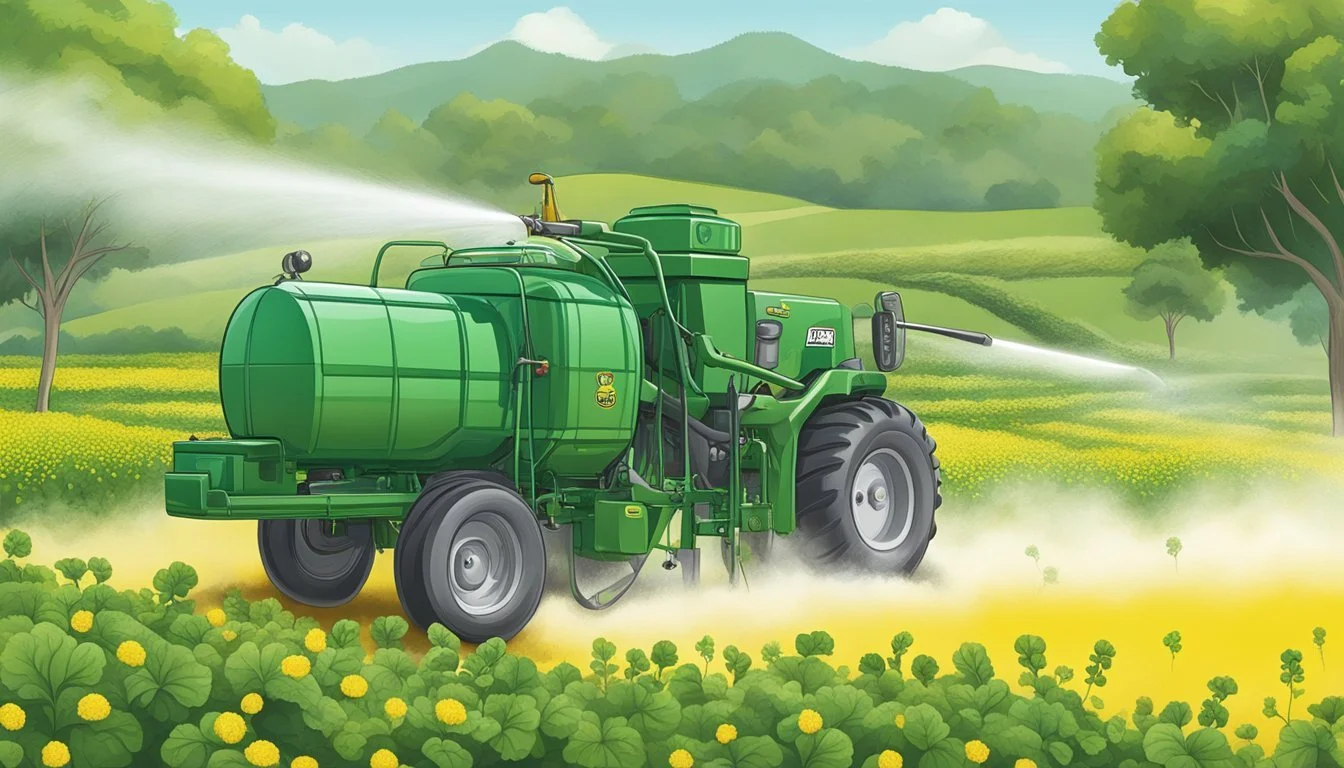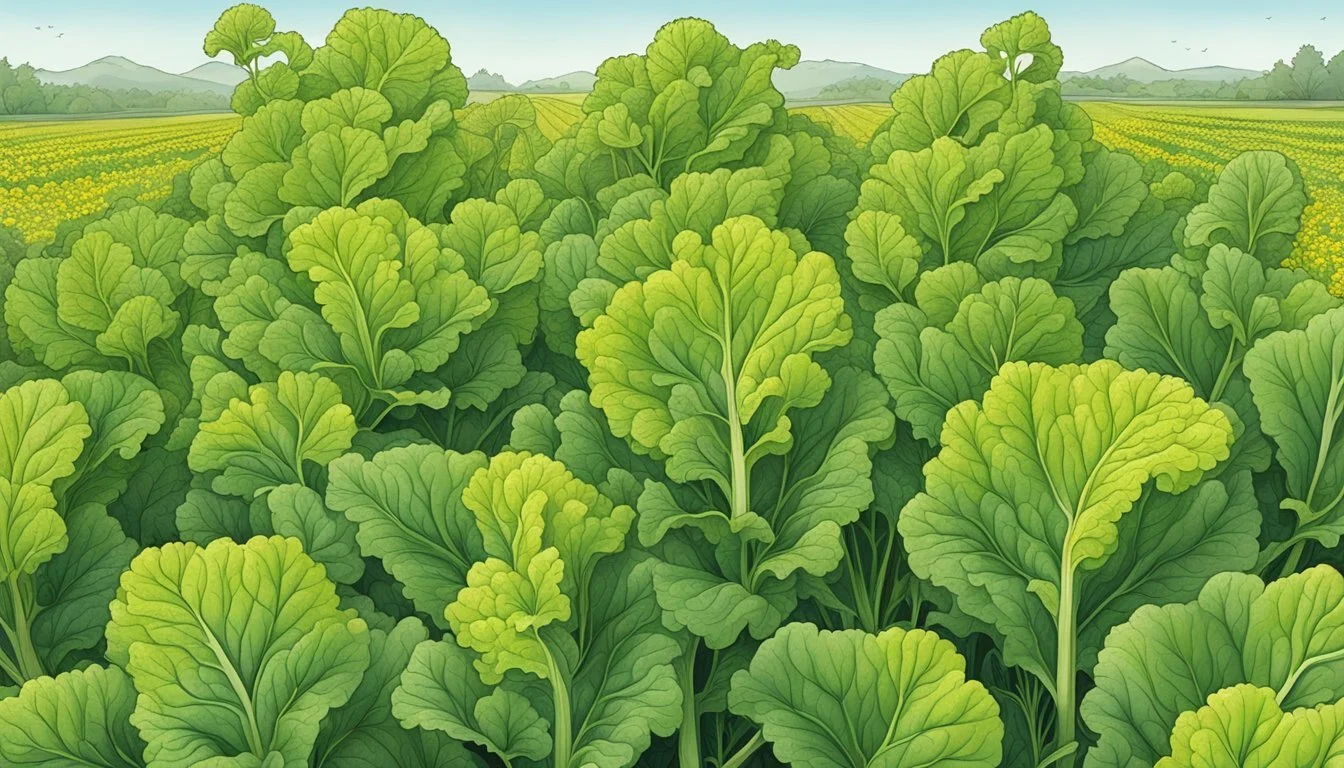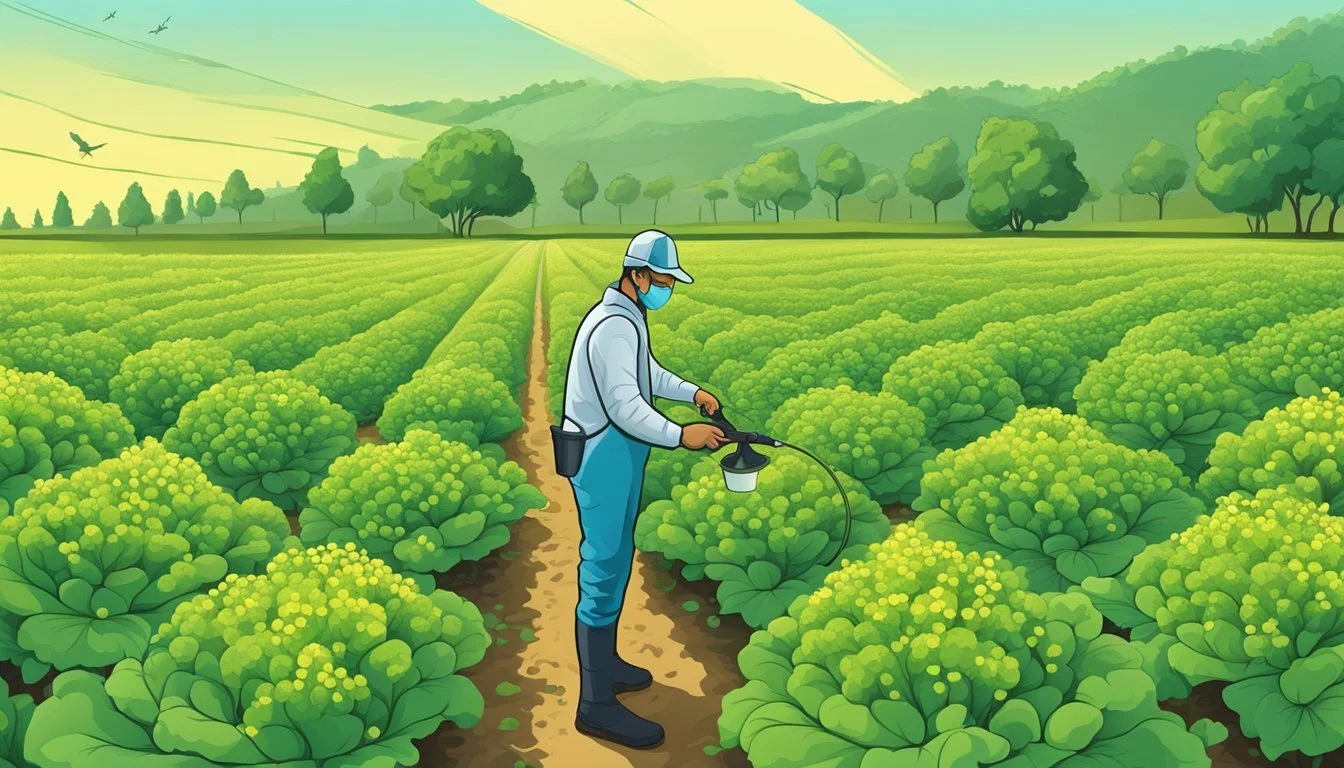Pest Control for Mustard Greens
Effective Strategies and Tips
Mustard greens are a nutritious leafy vegetable that can be a great addition to many dishes, offering a peppery flavor that enhances salads, soups, and stir-fries. However, like any crop, they can be susceptible to a variety of pests that threaten their growth and vitality. Effective pest control is essential for gardeners looking to ensure the health and productivity of their mustard green crops. Identifying and managing common pests such as aphids, flea beetles, and caterpillars is crucial for maintaining a thriving garden.
There are several strategies that gardeners can employ to protect their mustard greens from pests. Preventative measures, including crop rotation and the use of row covers, can significantly reduce the presence of pests. When infestations occur, identifying the specific pest is the first step in determining the appropriate control method. For some pests, organic solutions such as neem oil can be an effective treatment, promoting a healthy garden without the use of harsh chemicals.
In tackling diseases that affect mustard greens, such as downy mildew and leaf spot, the use of fungicides may be necessary. Alongside chemical interventions, cultural practices like good sanitation, proper watering techniques, and timing the harvest to avoid peak disease conditions are integral to disease management. By synthesizing proactive cultivation methods with targeted pest and disease control strategies, gardeners can ensure their mustard greens flourish and provide a bountiful harvest.
Understanding Mustard Greens
Mustard greens, a versatile and nutritious vegetable, exhibit a variety of characteristics across different cultivars and require specific conditions for optimal growth.
Characteristics of Varieties
Mustard green varieties exhibit a broad range of flavors, textures, and colors. Red Giant is known for its robust, peppery flavor and deep red-purple leaves, making it a visually striking addition to dishes. Ruby Streaks boasts finely serrated, spicy-tasting leaves with a touch of sweetness. For a milder taste, Florida Broadleaf presents wide, tender leaves, while Green Wave provides a curled, frilly texture with a bold, peppery kick. Southern Giant is yet another variant that offers large, flavorful leaves often used in traditional Southern cuisine.
Flavor Profile:
Red Giant: Robust, peppery
Ruby Streaks: Spicy, slightly sweet
Florida Broadleaf: Mild, tender
Green Wave: Bold, peppery
Southern Giant: Flavorful, classic
Leaf Characteristics:
Red Giant: Red-purple leaves
Ruby Streaks: Serrated leaves
Florida Broadleaf: Broad leaves
Green Wave: Curly texture
Southern Giant: Large leaves
Optimal Growth Conditions
To thrive, mustard greens require a certain set of conditions, where soil, temperature, light, and water play pivotal roles. They prefer a soil pH between 6.0 and 7.5 and benefit from well-drained, fertile soil rich in organic matter. When it comes to temperature, mustard greens are cool-weather crops ideally sown in early spring or late summer.
Soil Requirements:
pH: 6.0 - 7.5
Well-drained, nutrient-rich
Climate Preferences:
Temperature: Best between 45°F - 75°F
Sunlight: Full sun to partial shade
Water: Consistent moisture, avoid waterlogging
Spacing is essential for optimal growth, with recommendations varying by variety. Typically, seeds are sown 1/4 to 1/2 inch deep, with rows spaced 18-24 inches apart, allowing plants enough room to develop fully. Nutrient requirements include balanced fertilization, though mustard greens can also perform well in less fertile conditions compared to other leafy greens.
Soil Preparation and Planting
Proper soil preparation and planting are crucial for the health and productivity of mustard greens. This section will guide readers through the essential steps of soil management and pH balancing, seed selection and spacing, and planting techniques to ensure robust growth and yield.
Soil Management and pH Balancing
Mustard greens thrive in well-prepared soil that allows for adequate drainage yet retains moisture. It's important to incorporate organic matter into the soil, such as compost, to enhance its structure and nutrient content. The ideal pH level for mustard greens is between 6.0 and 7.0. To achieve this slightly acidic to neutral pH, gardeners can use a soil testing kit and adjust the pH accordingly with lime if the soil is too acidic or with sulfur if it's too alkaline.
Seed Selection and Spacing
Selecting high-quality seeds is essential for healthy mustard greens. When planting, ensure proper spacing to prevent overcrowding and to promote ample airflow around the plants, which can reduce the risk of disease. Seeds should be sown 1/2 inch deep into the soil, thinning seedlings to 2 to 4 inches apart in rows 16 to 24 inches apart. This spacing allows each plant room to grow and is critical for optimal development.
Seed Depth Seedling Spacing Row Spacing 1/2 inch 2 to 4 inches 16 to 24 inches
Planting Techniques
Planting techniques can involve direct sowing or starting seedlings indoors to transplant later. Mustard greens germinate best at soil temperatures between 45°F and 85°F. When transplanting, take care not to disturb the roots and make sure the soil is moistened thoroughly. Using pots can be a good option for growing mustard greens, especially in regions with limited garden space. Remember to incorporate crop rotation practices to maintain soil health and prevent disease carryover from previous plantings.
Pest Management Strategies
Effective pest management for mustard greens involves identification of common pests along with a multifaceted approach that includes the utilization of natural predators, organic control measures, and when necessary, chemical and biological treatments. Recognizing the importance of preventive practices is also crucial in maintaining the health of mustard green crops.
Common Pests Identification
Mustard greens are susceptible to various pests, including aphids, flea beetles, caterpillars, and whiteflies. Aphids are small, soft-bodied insects that cluster on the undersides of leaves, while flea beetles are tiny, dark-colored beetles that chew shot-hole patterns in the foliage. Caterpillars can cause extensive damage by eating the leaves, and whiteflies feed on plant sap, leading to yellowing and stunted growth.
Natural Predator Utilization
Beneficial insects such as ladybugs and lacewings are natural predators of many mustard pests, particularly aphids. Encouraging their presence through companion planting with flowers or herbs, such as mint or radishes, can provide a biological solution to pest control, reducing the need for chemical interventions.
Organic Control Measures
Organic control practices include companion planting with deterrents like beans, which can repel pests, and applying mulch to prevent some insects from reaching the plants. Regular watering practices can also affect pest populations. If an infestation occurs, products containing Bacillus thuringiensis (Bt), a natural soil-borne bacterium, can be applied to target caterpillars without harming beneficial organisms.
Chemical and Biological Treatments
When pest pressure is high, chemical treatments such as insecticides may be necessary, but they should be used judiciously to minimize environmental impact. Targeted biological treatments like Bt can also be effective. Always follow label instructions to protect both the crop and beneficial insects.
Preventive Practices
Preventive measures include crop rotation to reduce pest build-up in the soil and careful inspection of new plants before introducing them to the field or garden. Good sanitation practices, like removing plant debris, can discourage pests from overwintering and help avoid future infestations.
Irrigation and Fertilization Tactics
Optimal growth of mustard greens requires precise irrigation and fertilization strategies. A balance between soil moisture and nutrient supply is key for healthy plants.
Watering Requirements
Mustard greens thrive when the soil remains consistently moist, but not waterlogged. These leafy vegetables benefit from:
Regular watering: Ensure the plants receive 1 to 1.5 inches of water per week. This can be split into several watering sessions.
Soil type considerations: Sandy soils may necessitate more frequent watering, while clay soils hold moisture longer.
Nutrient Management
Fertilizing mustard greens should be tailored to provide adequate nutrients while avoiding over-fertilization. Consider the following:
Balanced fertilizer: A 10-10-10 or 14-14-14 NPK ratio is effective for leafy growth.
Organic matter: Incorporating well-rotted manure or compost can improve soil condition and nutrient availability.
Fertilization frequency: Apply a side-dressing of fertilizer roughly 25 days after planting to support continued growth.
Mustard Greens Care and Maintenance
Cultivating vibrant and healthy mustard greens necessitates diligent care, from keeping diseases and weeds at bay to managing harvest times effectively. Implementing strategic crop rotation and companion planting can bolster plant health and yield.
Weed and Disease Control
For mustard greens, preventing the proliferation of weeds and diseases is crucial. Regular weeding helps prevent competition for nutrients and reduces the hiding spots for pests. To combat diseases, observant gardeners watch for signs of fungal diseases such as downy mildew and white rust, bacterial diseases like bacterial leaf spot, and viral infections exemplified by mosaic virus. Removing affected plants and applying organic or chemical treatments—which must be used as instructed on labels—can help control these issues. How to Prevent and Manage Common Mustard Green Pests and Diseases.
Crop Rotation and Companion Planting
Successful mustard greens cultivation includes practicing crop rotation to prevent the accumulation of soil pathogens. One should rotate crops every two to three years to deter soil-borne diseases such as black rot and damping off. Companion planting is another botanical strategy where growing certain plants together naturally improves soil health, deterring pests and diseases. Integrating organic matter into the soil also augments its structure and fertility, benefiting the mustard greens. 15 Mustard Pests & Diseases (& How To Control Them).
Timely Harvesting
Harvesting mustard greens at the right time is essential to enjoy their optimal flavor and prevent bolting, where the plant prematurely goes to seed. Baby leaves can be collected as early as 20 to 25 days post-sowing, and mature leaves around 40 to 45 days. Regular harvests not only extend the production period but can also encourage new growth, ensuring a steady supply of greens. Growing Mustard Greens: The Complete Guide to Plant, Grow, & Harvest Mustard Greens.
Post-Harvest Handling
After harvesting mustard greens, appropriate post-harvest handling is critical to maintain their flavor, color, and nutrition. These leafy greens are not only edible and nutritious but their tender leaves can be a versatile ingredient in the kitchen.
Storage and Preservation
Storage Temperature and Humidity: Mustard greens should be stored in the refrigerator immediately after harvesting. They thrive at 32°F (0°C) with 90-95% relative humidity to stay fresh. at these conditions, they can last from 1 to 2 weeks.
Tips for Refrigeration:
Do not wash mustard greens before storing to avoid excess moisture.
Wrap them in a damp paper towel and place them inside a perforated plastic bag.
Store them in the crisper drawer to avoid crushing or bruising the tender leaves.
Mustard Greens in the Kitchen
Mustard greens add a peppery spice to dishes and are a nutritious addition to meals.
Preparation:
Rinse the leaves thoroughly in cold water before use to remove any dirt.
Trim away the tough stem parts; the leaves can be chopped or used whole.
Utilization:
Mustard greens can be eaten raw in salads or cooked in a variety of dishes.
Cooking them can tame the peppery spice if desired.
Troubleshooting Common Problems
Common Pests and Diseases:
Slugs and Snails: Handpick or use bait to mitigate.
Cabbage Loopers and Whiteflies: Introduce natural predators like lacewings to control these pests.
Powdery Mildew: Ensure adequate air circulation and keep foliage dry during watering.
Handling Issues:
Yellowing leaves indicate over-maturity or improper storage.
If leaves wilt, a quick soak in ice water can revive their crispness.
Remember, the key to optimal flavor and nutrition of mustard greens is how they are stored and preserved after harvest.
Cultivation Challenges and Solutions
Mustard greens, although hearty, face a number of challenges during cultivation that can be mitigated with proper care and vigilance. This section outlines critical considerations and solutions for maintaining healthy mustard green crops amidst variable climates, pest pressures, and growth anomalies.
Climate Considerations
Mustard greens thrive in cooler temperatures, generally preferring a range between 45°F to 75°F. They can tolerate light frosts, which may actually improve their flavor, but harsh freezes will damage the plants. Gardeners should monitor the climate closely and consider protective measures like row covers to shield the greens from late or unexpected frost.
Pest and Disease Resilience
Persistent pests and diseases can derail mustard green crops. Common issues include black rot, common in cabbage and broccoli and other members of the Brassica family, along with various insects that target these leafy greens. Farmers and gardeners should practice crop rotation and employ natural predators or organic treatments, such as neem oil, to manage these threats effectively.
Bolting and Growth Irregularities
When exposed to high temperatures or long daylight hours, mustard greens may bolt, or prematurely flower and go to seed, leading to a bitter taste and reduced leaf yield. To counteract bolting, growers should emphasize adequate soil nitrogen levels and consider planting bolt-resistant varieties such as mizuna, a close relative in the Brassica family.
Advanced Techniques and Innovations
The cultivation of mustard greens is evolving through progressive methods and innovations that optimize growth while fostering sustainability. These advancements pertain not just to improved growing techniques but also to the development of resilient plant varieties and sustainable agricultural practices.
Hydroponics and Vertical Farming
Hydroponics and vertical farming technologies have revolutionized the way mustard greens are grown. Utilizing these methods, one can cultivate mustard greens without soil, which allows for a significant reduction in water usage as the systems recycle water efficiently. Vertical farming saves space, enabling the growth of mustard greens in urban environments where traditional farming might not be feasible.
Advantages:
Increased yield: It allows for higher densities of mustard greens per square foot.
Conservation of resources: Reduces water usage by up to 70% compared to traditional farming.
Soil depletion prevention: Soil is not a factor, thus eliminating soil-borne diseases and the need for soil rotation.
Genetic Varietal Development
The development of new genetic varieties of mustard greens—part of the brassica family—aims at improving resistance to pests and diseases, enhancing flavor, and increasing nutritional content. Breeders are focusing on varieties that can thrive with less water, resist harsh weather conditions, and adapt to various climates—a boon for ensuring food security in changing environmental conditions.
Selective breeding: It has led to varieties that are more robust against common pests, which can reduce reliance on chemical pesticides.
Genetic modification: While more controversial, it carries potential to create mustard greens that have built-in resistance to issues that traditionally threaten yields.
Sustainable Agriculture Practices
Sustainable agriculture practices emphasize the health of the ecosystem, including the quality of soil and water, while also meeting human food requirements. For mustard greens cultivation, this includes introducing compost to enhance organic matter in the soil, using companion planting to deter pests naturally, and implementing rotation strategies to break pest and disease cycles.
Compost and Organic Matter: Adding compost enriches the soil, improving its structure and providing essential nutrients for growing mustard greens.
Companion Planting and Rotation: These tactics not only aid in pest control but also optimize space and utilize beneficial interactions between different vegetables to boost overall garden health.
Frequently Asked Questions
This section aims to address common concerns about pest control in mustard greens, offering natural remedies, homemade solutions, and recommendations for commercial pesticides to protect your crops effectively.
What are the best natural remedies for controlling pests on mustard greens?
Natural remedies for mustard greens include introducing beneficial insects, such as ladybugs, to eat aphids. Another method involves sprinkling diatomaceous earth around the plants to deter crawling pests.
How can I create a homemade pest control solution for my mustard greens?
A homemade pest control solution can be made using neem oil or a mixture of water, dish soap, and peppermint oil to spray on mustard greens, deterring a variety of pests.
What are the most effective pesticides specifically suited for mustard greens?
For mustard greens, pesticides containing spinosad or pyrethrin are known to be effective. How to Prevent and Manage Common Mustard Green Pests and Diseases provides insights into appropriate pesticides.
Can neem oil be used as an effective pest control for mustard greens, and how should it be applied?
Yes, neem oil is effective for mustard greens pests. It should be diluted as per the instructions and sprayed directly onto the foliage, preferably in the cooler parts of the day to avoid leaf burn.
How do you manage white spot infestations safely on mustard greens?
White spot, or powdery mildew, is managed by improving air circulation, reducing leaf wetness, and applying fungicides. It's crucial to remove and destroy affected plant parts to prevent spread.
What are some proven strategies for keeping bugs away from turnip and mustard greens?
Proven strategies include crop rotation, proper spacing to improve air circulation, using floating row covers, and maintaining soil health to boost plant resistance against bugs.







